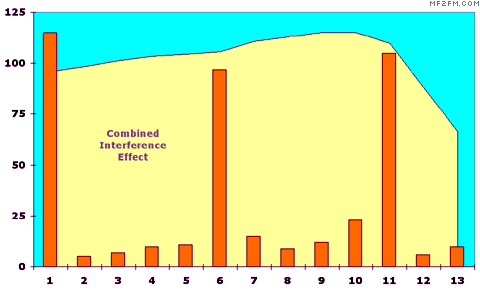Thursday 26 June, 2008, 06:51 - Radio Randomness
Another long train journey, another opportunity to run Netstumbler to find out what is going on in the world of WiFi. On this journey 425 WiFi (802.11b and 802.11g) access points were identified. No 802.11a (5 GHz) access points were spotted. Of these, 24% were not encrypted or protected in any way (however, some of these are public access points such as 'BT OpenZone' and so would not be expected to be encrypted). This means that the proportion of home WiFi nodes that are now protected has gone up significantly since the last time this was tested.The graph below shows, in orange, the number of times that each channel was found to be in use. As expected, channels 1, 6 and 11 were the most commonly used, with channel 1 winning out over channel 11 in terms of usage for a change.

What the graph also shows is the combined interference effect of all the nodes across the whole WiFi frequency band. This has been done by adding the use of a channel with (5-n)/5 times the use of the frequency n channels away. So a channel 3 frequencies away from the channel in question would add 2/5ths of its interference to the total combined effect. This takes account of the OFDM nature of WiFi and thus the fact that the less two channels overlap, the lower the interference problem.
What's interesting about this result is that interfernece remains fairly constant across the whole band, with the exception of channels 12 and 13. This is perhaps not surprising as, channel 9, for example, will suffer 3/5ths of the interference in busy channel 11, and 2/5 of the interference in busy channel 6. Only when we get above channel 11 does interference fall as only one busy channel (11) is now adding to the combined interference 'mush'.
The frequencies above channel 13 (i.e. above 2483.5 MHz) are not used for WiFi and although no account has been taken of usage above (or below) the band, if usage is not widespread (at present it is reserved for an as yet non operational satellite system), then the overall level of interference in channels 12 and 13 will, indeed, be lower.
